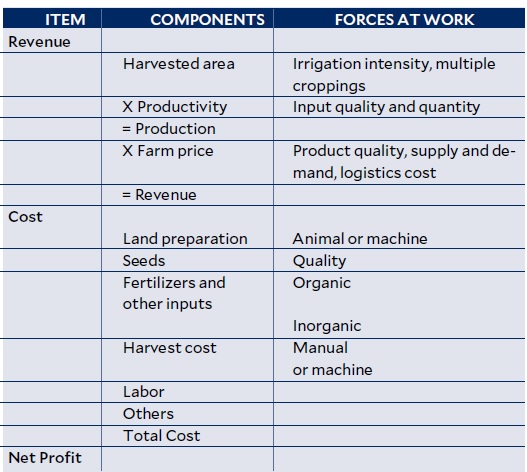Agricultural Economics 001
Of late, I was struck by a commentator who said that farm productivity was not that important. That farm net income is. This is difficult to reconcile as the two are related.
In my decades of observing Asean agriculture, I have found that productivity matters. Across Asean—Indonesia, Malaysia, Thailand and Vietnam—where farm productivity is high, rural poverty is low. I was an agriculture project economist in Malaysia and Thailand in my younger days doing small-scale rice irrigation, oil palm planting, rubber replanting and rural roads.
I was involved in Malaysia’s Federal Land Consolidation and Rehabilitation Authority (FELCRA) and Rubber smallholder Industry Smallholder Development Authority (RISDA). The University of Asia and the Pacific (UA&P) agribusiness team has done benchmarking studies in coffee, dairy, livestock, poultry, rubber and sugar in the past seven years.
Let’s go back to basics. The simple equation is: Profit = Revenue – Cost. Revenue is influenced by harvested area x productivity x farm price. Relatedly, cost is affected by land preparation, seeds, fertilizers, pesticides, labor, land rent, land amortization, and interest expense.
Revenue
Irrigation can “double” rice crops in one year from the same land with adequate water. Rice can be harvested in 90 to 100 days. Agribusiness expert Toto Barcelona claims that one can even quadruple harvests in the same area with high-value crops under modern irrigation, such as drip irrigation or micro-sprinkler. Sweet corn can be harvested in 70 days. Cucumber in 50 days.
Productivity is a result of technology—inputs, water, and management. Of course, there are risk factors, such as climate change—drought, floods and typhoons. This is where crop insurance and disaster relief come in.
Lower yield under low inputs can be compensated by high price. For example, mountain (heirloom) rice has lower yield but often twice the price. Profits can even be higher with farm-based vermicast fertilizers.
Cost
High productivity is often cost-driven. Productivity and quality start with good seeds. Good seeds cost more. Recommended fertilizers normally require larger quantities.
Machines cost more but do the job faster than animals or humans. For sugar, machine plowing is imperative to reach at least 60 centimeters deep. Carabao plowing is a sure way to low sugarcane yield.
Machine harvesting is faster and incur low harvest losses. The Basi Multipurpose Coop in Piddig, Ilocos Norte, runs a small rice harvester that can harvest eight tons a day. It takes 100 person-days to do the same. Faster and cheaper.
Mechanized farming requires scale. Thus the need to organize or consolidate farmers for scheduling. This is being done by sugar mill district development councils.
 One advocate said that farmers’ incomes can be raised at low yield and at low input. This is feasible provided farm output has a premium and/or inputs are minimal and mostly farm-based. But take note of market absorption. This is also well-suited for home gardens. The Asian Vegetable Research Development Center, once headed by our very own Dr. Emil Javier, has espoused home gardens as early as the 1970s.
One advocate said that farmers’ incomes can be raised at low yield and at low input. This is feasible provided farm output has a premium and/or inputs are minimal and mostly farm-based. But take note of market absorption. This is also well-suited for home gardens. The Asian Vegetable Research Development Center, once headed by our very own Dr. Emil Javier, has espoused home gardens as early as the 1970s.
A few years ago in a Davao workshop (my hometown), an advocate vouched for converting banana farms to organic. Someone reacted: What will happen to export volume if all the 80,000 hectares go organic immediately? The country exports nearly three million tons of Cavendish a year. Note: Our faulty statistics showed only 1.4 million tons ($618 million) in 2016. In reality, it exported 2.9 million tons in five main markets—China, Japan, Korea, Saudi Arabia and Kuwait—alone.
Is there a market for organic bananas? Yes. But it is small. Peru, the major global player, exported 200,000 tons valued at $153 million in 2016. The average export price was $0.76 per kilo ($10 per box), twice that of common types.
What do all these mean? There are technology options in farming which impact on revenues and costs. Revenues are almost always driven by markets, product quality and productivity. Costs are influenced by farmers’ resources and how these are combined through effective management.
Going low input, low yield, and high product price is an option provided there are markets. And there are market niches. What’s worrying about this route if it will encompass all products is its downstream impact on agri-industry. Many of the agri-processing plants are operating at 50 percent capacity utilization, from coconut oil milling to fruit processing to sugar milling due to lack of raw materials. Why? Low farm productivity.
Consider always how much product your market can absorb, beyond home consumption. It is all about farmers’ choices and consumers’ choices.
Note: My latest book, Agribusiness and Rural Progress. Actions for Poverty Reduction, was launched on March 21. For copies/inquiries, please contact [email protected] or 634-2819.














